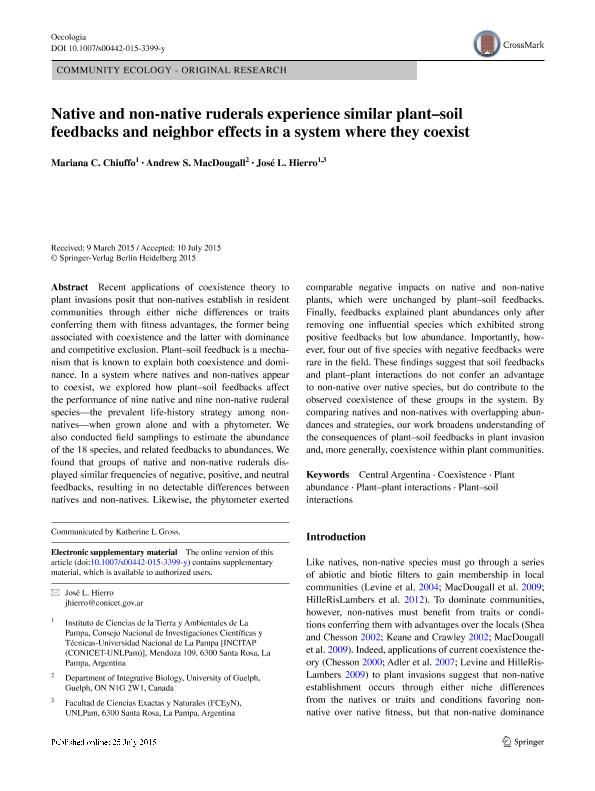Mostrar el registro sencillo del ítem
dc.contributor.author
Chiuffo, Mariana Cecilia

dc.contributor.author
MacDougall, Andrew S.
dc.contributor.author
Hierro, Jose Luis

dc.date.available
2017-06-29T15:51:25Z
dc.date.issued
2015-07
dc.identifier.citation
Chiuffo, Mariana Cecilia; MacDougall, Andrew S.; Hierro, Jose Luis; Native and non-native ruderals experience similar plant: soil feedbacks and neighbor effects in a system where they coexist; Springer Heidelberg; Oecologia; 179; 3; 7-2015; 843-852
dc.identifier.issn
0029-8549
dc.identifier.uri
http://hdl.handle.net/11336/19121
dc.description.abstract
Recent applications of coexistence theory to plant invasions posit that non-natives establish in resident communities through either niche differences or traits conferring them with fitness advantages, the former being associated with coexistence and the latter with dominance and competitive exclusion. Plant–soil feedback is a mechanism that is known to explain both coexistence and dominance. In a system where natives and non-natives appear to coexist, we explored how plant–soil feedbacks affect the performance of nine native and nine non-native ruderal species—the prevalent life-history strategy among non-natives—when grown alone and with a phytometer. We also conducted field samplings to estimate the abundance of the 18 species, and related feedbacks to abundances. We found that groups of native and non-native ruderals displayed similar frequencies of negative, positive, and neutral feedbacks, resulting in no detectable differences between natives and non-natives. Likewise, the phytometer exerted comparable negative impacts on native and non-native plants, which were unchanged by plant–soil feedbacks. Finally, feedbacks explained plant abundances only after removing one influential species which exhibited strong positive feedbacks but low abundance. Importantly, however, four out of five species with negative feedbacks were rare in the field. These findings suggest that soil feedbacks and plant–plant interactions do not confer an advantage to non-native over native species, but do contribute to the observed coexistence of these groups in the system. By comparing natives and non-natives with overlapping abundances and strategies, our work broadens understanding of the consequences of plant–soil feedbacks in plant invasion and, more generally, coexistence within plant communities.
dc.format
application/pdf
dc.language.iso
eng
dc.publisher
Springer Heidelberg

dc.rights
info:eu-repo/semantics/openAccess
dc.rights.uri
https://creativecommons.org/licenses/by-nc-sa/2.5/ar/
dc.subject
Central Argentina
dc.subject
Coexistence
dc.subject
Plant Abundance
dc.subject
Plant-Soil Interactions
dc.subject
Plant-Plant Interactions
dc.subject.classification
Ecología

dc.subject.classification
Ciencias Biológicas

dc.subject.classification
CIENCIAS NATURALES Y EXACTAS

dc.title
Native and non-native ruderals experience similar plant: soil feedbacks and neighbor effects in a system where they coexist
dc.type
info:eu-repo/semantics/article
dc.type
info:ar-repo/semantics/artículo
dc.type
info:eu-repo/semantics/publishedVersion
dc.date.updated
2017-06-29T13:58:08Z
dc.identifier.eissn
1432-1939
dc.journal.volume
179
dc.journal.number
3
dc.journal.pagination
843-852
dc.journal.pais
Alemania

dc.journal.ciudad
Heidelberg
dc.description.fil
Fil: Chiuffo, Mariana Cecilia. Consejo Nacional de Investigaciones Científicas y Técnicas. Instituto de Ciencias de la Tierra y Ambientales de La Pampa. Universidad Nacional de La Pampa. Facultad de Ciencias Exactas y Naturales. Instituto de Ciencias de la Tierra y Ambientales de La Pampa; Argentina
dc.description.fil
Fil: MacDougall, Andrew S.. University of Guelph; Canadá
dc.description.fil
Fil: Hierro, Jose Luis. Consejo Nacional de Investigaciones Científicas y Técnicas. Instituto de Ciencias de la Tierra y Ambientales de La Pampa. Universidad Nacional de La Pampa. Facultad de Ciencias Exactas y Naturales. Instituto de Ciencias de la Tierra y Ambientales de La Pampa; Argentina. Universidad Nacional de La Pampa. Facultad de Ciencias Exactas y Naturales; Argentina
dc.journal.title
Oecologia

dc.relation.alternativeid
info:eu-repo/semantics/altIdentifier/doi/http://dx.doi.org/10.1007/s00442-015-3399-y
dc.relation.alternativeid
info:eu-repo/semantics/altIdentifier/url/https://link.springer.com/article/10.1007%2Fs00442-015-3399-y
Archivos asociados
